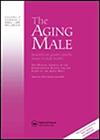HEAT-Registry(睾酮对造血的影响):在性腺功能低下的男性中,透皮凝胶与长效肌注十一酸睾酮的比较
IF 2.7
4区 医学
Q3 ENDOCRINOLOGY & METABOLISM
引用次数: 5
摘要
性腺功能低下男性的睾酮(T)治疗需要稳定的动力学,耐受性和症状的衰减。肌内注射长效十一酸T酯(TU)和透皮应用T凝胶提供了已证实的疗效。由于T对造血有明显的影响,在T治疗时必须考虑到红细胞压积的升高。目的比较经皮T凝胶与长效肌注TU对造血、年龄、诊断、雄激素受体易感性和肥胖的影响。设计前瞻性双臂开放注册,每位患者最少持续26周。进入回归模型的推测的促红细胞生成调节因子包括药物类型、性腺功能减退类型、总睾酮浓度、腰围、年龄以及雄激素受体基因CAG重复长度(在一个亚组中)。设置以大专院校为基础的男科门诊部。802例性腺功能低下男性,498例接受T凝胶治疗,304例接受肌注TU治疗,中位年龄40岁(四分位数间距= 25)。结果治疗开始后随访时间为治疗周26 ~ 30周。两组患者血清T浓度均显著升高。接受肌内TU治疗的男性红细胞压积(>50%)明显高于接受T凝胶治疗的男性(69/304 vs. 25/498, p 52%和>54%)。在逐步多元回归模型中,高龄(p = 0.009)、较高的腰围(p = 0.01)、较高的δ睾酮(p = 0.007)和功能性与经典性腺功能减退(p = 0.04)是影响因素。在574例患者的亚组中,雄激素作用减弱(雄激素受体CAG重复数较长)减轻了效果(p = 0.01)。男性贫血(血红蛋白≤12.7 g/dl)患者在接受TU / T凝胶治疗时更容易偏离病理范围(41/53 vs. 49/89 p = 0.01)。结论肌注TU替代T或T凝胶可有效提高T浓度。长效TU可使红细胞压积水平提高至50%,同时在性腺功能低下患者亚组中改善贫血似乎更有效。这尤其适用于患有功能性性腺功能减退症的肥胖老年男性。本文章由计算机程序翻译,如有差异,请以英文原文为准。
The HEAT-Registry (HEmatopoietic Affection by Testosterone): comparison of a transdermal gel vs long-acting intramuscular testosterone undecanoate in hypogonadal men
Abstract Context Testosterone (T) therapy of hypogonadal men requires stable kinetics, tolerance and attenuation of symptoms. Both intramuscular injections of the long-acting ester T undecanoate (TU) and transdermal application of T gel offer a proven efficacy. As T has marked effects on hematopoiesis, an elevation of hematocrit has to be considered during T therapy. Objective To compare the effects of a transdermal T gel with long-acting intramuscular TU on hematopoiesis, controlling for age, diagnosis, androgen receptor susceptibility and obesity. Design Prospective two-arm open registry, minimum duration of 26 weeks per patient. Putative modulators of erythropoiesis entering regression models were type of medication, type of hypogonadism, delta of total testosterone concentrations, waist circumference, age as well as (in a sub-group) androgen receptor gene CAG repeat length. Setting Tertiary university based andrological outpatient department. Patients 802 hypogonadal men, 498 receiving T gel and 304 receiving intramuscular TU, median age 40 years (interquartile range = 25). Results Follow-up visits after initiation of treatment occurred between treatment weeks 26-30. Serum T concentrations increased markedly in both patient groups. Men receiving intramuscular TU exhibited an increased hematocrit (>50%) to a significantly higher amount than men receiving T gel (69/304 vs. 25/498, p < 0.001). Corresponding results were seen for higher values of hematocrit (>52% and >54%). Advanced age (p = 0.009), higher waist circumference (p = 0.01), higher delta testosterone (p = 0.007) and functional vs classical hypogonadism (p = 0.04) contributed to the effect in stepwise multiple regression models. Attenuated androgen action (longer androgen receptor CAG repeats) mitigated the effect (p = 0.01) in a subgroup of 574 patients. Men with anemia (hemoglobin ≤12.7 g/dl) were more likely to move out of the pathological range when receiving TU vs T gel (41/53 vs. 49/89 p = 0.01). Conclusions T substitution with intramuscular TU or T gel increase T concentrations effectively. Long-acting TU leads to a higher rate of hematocrit levels >50%, whilst at the same time it seems to be more efficient to ameliorate anemia in the subgroup of respectively affected hypogonadal patients. This applies especially to obese older men with functional hypogonadism.
求助全文
通过发布文献求助,成功后即可免费获取论文全文。
去求助
来源期刊

Aging Male
医学-泌尿学与肾脏学
CiteScore
6.40
自引率
3.80%
发文量
33
审稿时长
>12 weeks
期刊介绍:
The Aging Male , the official journal of the International Society for the Study of the Aging Male, is a multidisciplinary publication covering all aspects of male health throughout the aging process. The Journal is a well-recognized and respected resource for anyone interested in keeping up to date with developments in this field. It is published quarterly in one volume per year.
The Journal publishes original peer-reviewed research papers as well as review papers and other appropriate educational material that provide researchers with an integrated perspective on this new, emerging specialty. Areas of interest include, but are not limited to:
Diagnosis and treatment of late-onset hypogonadism
Metabolic syndrome and related conditions
Treatment of erectile dysfunction and related disorders
Prostate cancer and benign prostate hyperplasia.
 求助内容:
求助内容: 应助结果提醒方式:
应助结果提醒方式:


